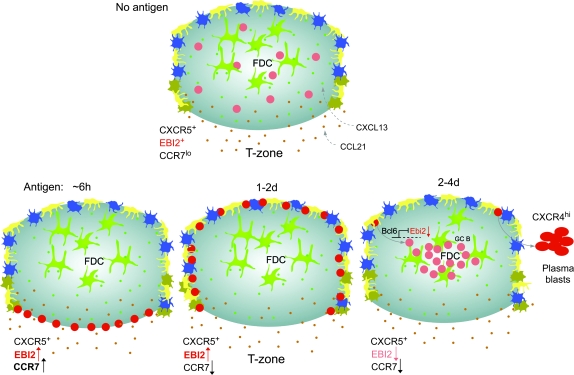Fig. 2.
Model of EBI2 ligand distribution and B-cell migration in follicles during the early phase of T-cell-dependent antibody responses in spleen and lymph nodes. Naive B cells (pink circles) express CXCR5 and EBI2, reside in follicles and migrate over the processes of FDCs (green), MRCs (yellow), CD169+ macrophages (dark blue) and likely other stromal cells (not depicted). FDCs and MRCs produce CXCL13 (small green dots) and EBI2 ligand is suggested to be made by cells at the follicle perimeter, particularly in inter and outer follicular regions (blue–green gradient, where dark shading represents areas of highest ligand concentration). B-cell movement within the FDC-rich area is largely dependent on CXCR5 and CXCL13 and is critical for antigen scanning. Within 6 h after encountering cognate antigen, activated B cells (red circles) up-regulate CCR7 and EBI2. Activated B cells become more responsive to CCL21 (orange dots) and most likely to EBI2 ligand, while maintaining CXCR5 responsiveness. Balanced chemoattraction mediated by CXCR5 and CCR7, and possibly also responsiveness to local EBI2 ligand, promotes uniform distribution of activated B cells along the interface between follicles and T-cell areas (B/T zone), where cognate interactions with antigen-specific T cells are initiated. Between 1 and 2 days later, B cells down-regulate CCR7 while maintaining high levels of EBI2 (and CXCR5) and move to inter and outer follicular regions where EBI2 ligand concentration might be highest (dark shading). Inter and outer follicular niches are characterized by layers of CD169+ macrophages and MRCs and the interfollicular niche also contains dendritic cells (brown cells). B-cell proliferation and commitment to plasmablast or GC differentiation pathway ensues, perhaps influenced by signals received from local niche cells. Some activated B cells differentiate into plasmablasts and accumulate at extrafollicular sites in a CXCR4-dependent manner. Other activated B cells up-regulate Bcl6, which represses Ebi2, and take on a GC fate. GC-committed B cells move to the center follicle due to loss of EBI2 and perhaps attracted by CXCL13 or another FDC-derived cue and initiate the GC reaction that will produce high-affinity memory B cells and plasma cells.

